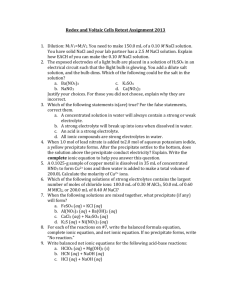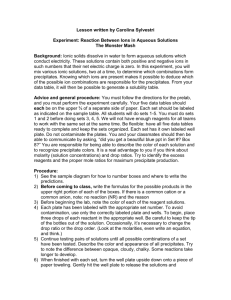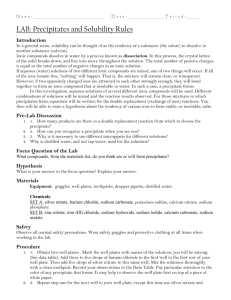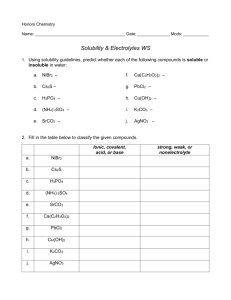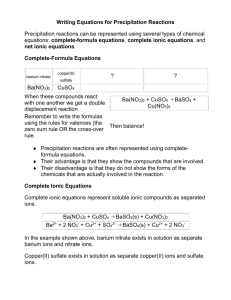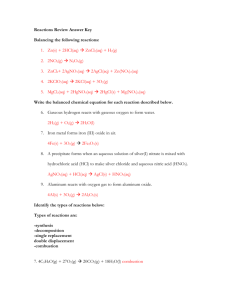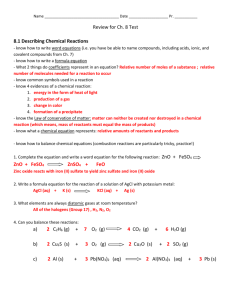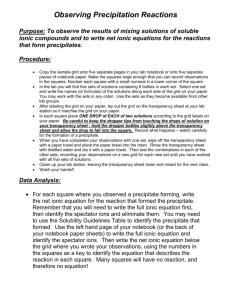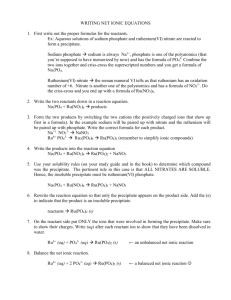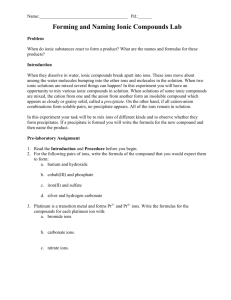Here
advertisement
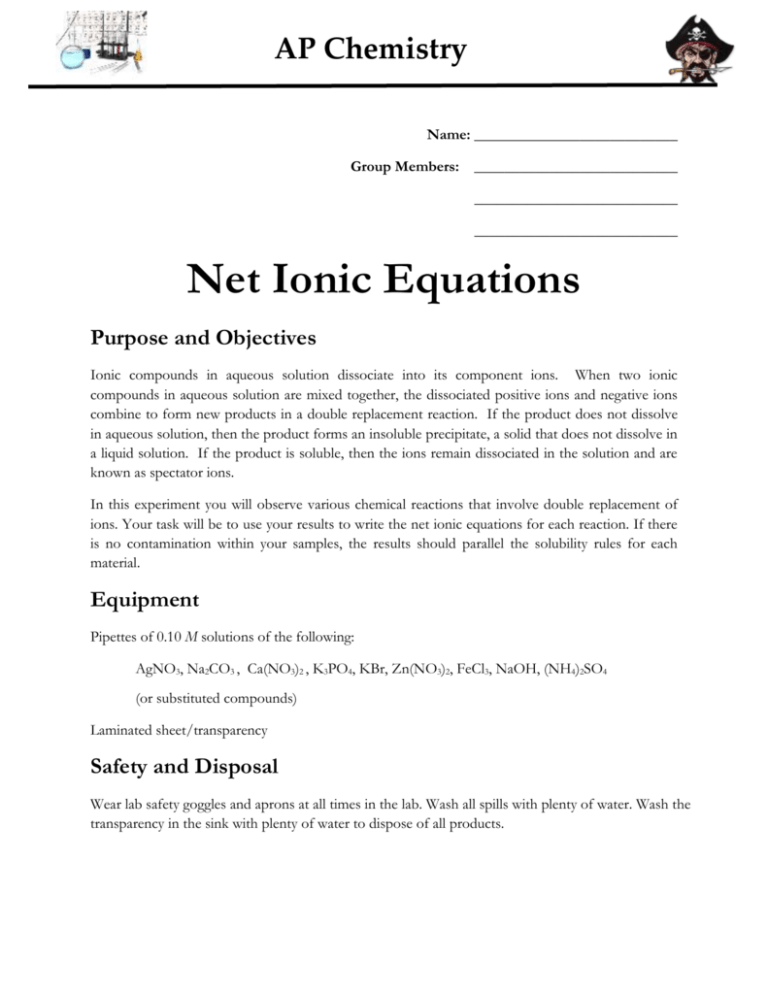
AP Chemistry Name: ___________________________ Group Members: ___________________________ ___________________________ ___________________________ Net Ionic Equations Purpose and Objectives Ionic compounds in aqueous solution dissociate into its component ions. When two ionic compounds in aqueous solution are mixed together, the dissociated positive ions and negative ions combine to form new products in a double replacement reaction. If the product does not dissolve in aqueous solution, then the product forms an insoluble precipitate, a solid that does not dissolve in a liquid solution. If the product is soluble, then the ions remain dissociated in the solution and are known as spectator ions. In this experiment you will observe various chemical reactions that involve double replacement of ions. Your task will be to use your results to write the net ionic equations for each reaction. If there is no contamination within your samples, the results should parallel the solubility rules for each material. Equipment Pipettes of 0.10 M solutions of the following: AgNO3, Na2CO3 , Ca(NO3)2 , K3PO4, KBr, Zn(NO3)2, FeCl3, NaOH, (NH4)2SO4 (or substituted compounds) Laminated sheet/transparency Safety and Disposal Wear lab safety goggles and aprons at all times in the lab. Wash all spills with plenty of water. Wash the transparency in the sink with plenty of water to dispose of all products. AP Chemistry Pre-lab Questions: 1. Where do you expect to observe precipitates? In the data table (back side of this lab paper), place a small “x” in the upper left hand corner of the appropriate boxes to indicate where you expect to observe precipitates according to the solubility rules. Also write the formula of the precipitate you expect to see in the upper right-hand corner of the box. 2. Copy down the exact data table in your lab notebook (it has to look the exactly the same – it must fit on only ONE lab sheet). Write the formula of the precipitate that you expect to see form according of the solubility rules in the upper right-hand corner of the appropriate box. Make sure to leave enough room for observations in the data table (see Procedure #3). [Don’t forget to do an initial observation table of the reactants BEFORE you mix them!] Procedure 1. Obtain the necessary pipets and a transparency. 2. Place the transparency on the laminated chart and carefully add one drop of each chemical in the appropriate square. You want to place each drop on the point where the white cell and the black cell meet in order to observe the colors better. Be sure that the tips of the pipets do not touch the surface of the transparency or any other solution in order to avoid contamination. 3. After placing the solutions in each box (may need to wait about 30 seconds), record your observations in each box of your data table. For observations, specify the following in this order: a.) the color or if no color – write “colorless” b.) opaque, cloudy, or transparent/clear c.) presence of a precipitate; write “i” for insoluble d.) absence of a precipitate; write “s” for soluble * it may be helpful to make a key/legend on the bottom right-hand corner of the lab sheet. 4. Wash the transparency in the sink, completely dry the transparency, and return it to the appropriate place. 5. Clean up. Wipe and dry the lab table. Wash your hands. AP Chemistry Name: ___________________________ Group Members: ___________________________ ___________________________ ___________________________ NET IONIC EQUATIONS LAB DATA SHEET Data Table Al(NO3) 3 (NH4) 2SO4 NaOH FeCl3 Zn(NO3) 2 KBr K3PO4 Ca(NO3) 2 AgNO3 Na2CO3 Ca(NO3) 2 K3PO4 KBr Zn(NO3) 2 FeCl3 NaOH (NH4) 2SO4 Data Analysis Write the balanced net ionic reaction for each observed and expected reaction. Do not include states of matter. Write all equations in a column and in order as follows: Number each equation. First write net equations for AgNO3 as it reacts with the reagents listed across the horizontal row. Then write net ionic equations for Na2CO3 as it reacts with the reagents across the horizontal row. Then write net ionic equations for Ca(NO3)2 as it reacts with chemicals across the horizontal row. Continue writing equations for the remaining reagents down the column as they react with reagents across the horizontal row. If observations did not conform to the theory of solubility rules: Na2CO3 AP Chemistry place a star () in the box and next to the written equation if a precipitate was supposed to form but was not observed; place a diamond () in the box and next to the written equation if a precipitate was not supposed to form and it did (for these, write the balanced molecular equation with phases since there isn’t a net ionic reaction). Conclusion

